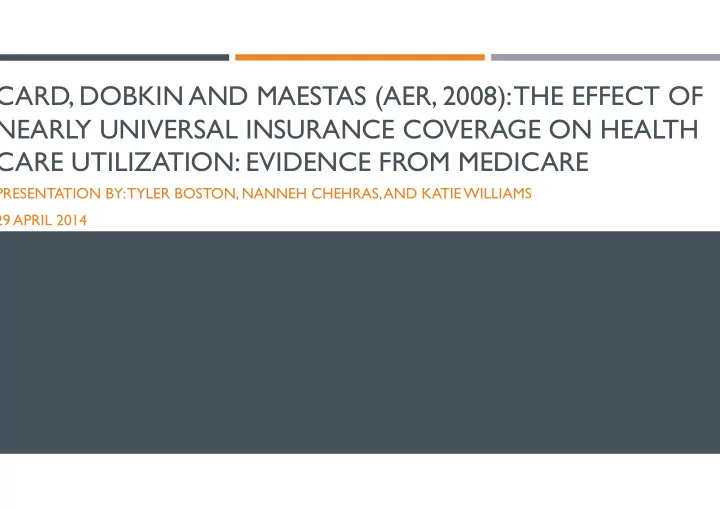

CARD, DOBKIN AND MAESTAS (AER, 2008): THE EFFECT OF NEARLY UNIVERSAL INSURANCE COVERAGE ON HEALTH CARE UTILIZATION: EVIDENCE FROM MEDICARE PRESENTATION BY: TYLER BOSTON, NANNEH CHEHRAS, AND KATIE WILLIAMS 29 APRIL 2014
MOTIVATION ¡ 1/5 of nonelderly lack health insurance (mostly disadvantaged) ¡ <1 percent of elderly lack health insurance (mostly Medicare coverage) ¡ Credible evidence on the impact of health insurance on access to care and utilization is limited ¡ RQ: Does better insurance coverage lead to better health outcomes?
BASIC RESEARCH DESIGN ¡ Want to estimate the causal effect of health insurance status (X) on health care usage (Y) ¡ Problem: Insurance coverage is endogenous (insurance depends on health status) ¡ Solution: Exploit exogenous variation in insurance status due to age threshold for Medicare eligibility ¡ Regression Discontinuity (RD) design ¡ Compare health-related outcomes among people just before and just after the age of 65 ¡ What are the effects of reaching age 65 on access to care and utilization of health care services?
CHANGE IN INSURANCE COVERAGE AT 65 ¡ Medicare causes sharp increase in coverage at 65, especially for disadvantaged
DATA ¡ Survey data from the National Health Interview Survey (NHIS), 1992-2003 ¡ Self-reported data ¡ Access to care (delay of care due to cost) ¡ Health care utilization variables: number of recent doctor visits, recent hospital stays ¡ Hospital discharge records from California, Florida, and New York, 1992-2003 ¡ Data on hospital admissions for specific conditions and procedures, and by hospital type ¡ Age and race/ethnicity
ECONOMETRIC DESIGN ¡ Use linear probability model, interact quadratic age (in quarters) with over-65 status ¡ Aggregate by demographic groups ¡ First fit model for insurance outcomes, then health care outcomes ¡ Also regress discontinuity in healthcare outcomes at 65 on discontinuity in insurance at 65 across demographic groups ¡ This indicates whether this is the primary explanation for differences
CHECKING THE RD ASSUMPTION
RESULTS
CRITIQUES RD assumption for continuity requires that all other factors that might affect the outcome of interest 1. trend smoothly at 65 ¡ Retirement – smooth at 65, but evidence of discrete drop at age 62 (early retirement) ¡ Would like to see analysis at age 62 since it may be a confounding factor that is changing discontinuously near 65 – RD may be invalid ¡ Kink? Would like to see more robustness checks to specification 2. ¡ Change age polynomial Self-reported data 3. ¡ People have bad memories and sample is older, may bias results ¡ Questions refer to previous year, so effect not at 65 (maybe analyze t+1) Would like to see probability of coverage broken up by type. 4. Motivation could be better - not comparing old versus young, comparing just before and after 65 5.
RELATED PAPER: CARD, DOBKIN AND MAESTAS (QJE 2009): “DOES MEDICARE SAVE LIVES?” ¡ Research Question: What are the health effects of Medicare? ¡ Existing literature shows that utilization of health care services increases once people become eligible for Medicare, but do not look at health impacts ¡ Data on hospital discharge records in CA 1992-2002 ¡ RD design – measures impact of changes in health insurance characteristics at age 65 on mortality ¡ Compare differences in mortality for severely ill people who are admitted to CA hospitals just before and after 65 th birthdays ¡ Avoids sample selection problem (insurance status affects probability that patient admitted to hospital)
RESULTS: “DOES MEDICARE SAVE LIVES” (2009) Estimate a nearly 1 percentage point drop in 7-day mortality for • Patients over 65 receive more services patients at age 65 (20% reduction in deaths for severely ill patients • Mortality gap persists for at least 9 months after admission •
Recommend
More recommend